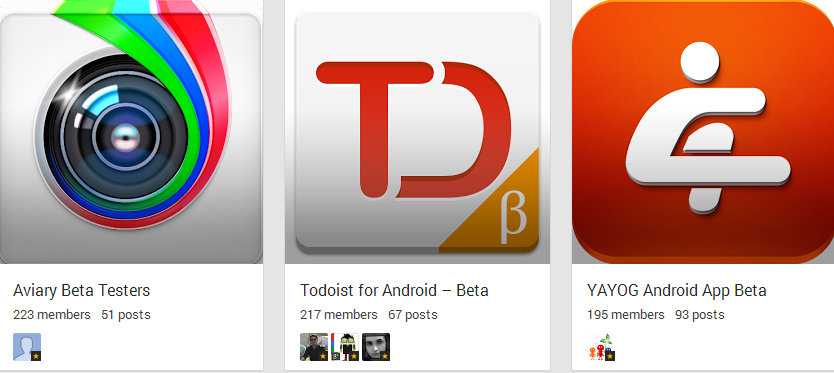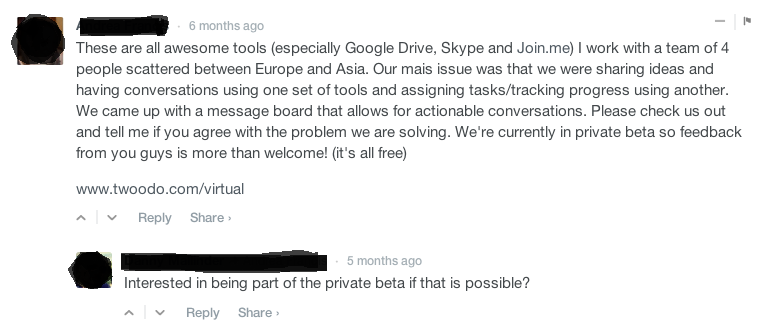This article shows you:
- an overview of common tools used to find beta testers
- a list of methods and “how-to” steps to avoid paying to acquire beta testers
Liam Gooding from Trak.io has a fantastic list of resources to find beta testers here.
But how do you find beta testers for free? Paying for as little as possible (i.e. bootstrapping) is significant at the startup stage. Whilst I agree with most of his suggestions, there are some issues with the current “free” beta testing resources.
Why services to find beta testers are not so budget-friendly
Betalist, Startuplist and Erlibird are all extremely useful services - some SaaS startups might even say imperative to success - but:
- some Erlibird beta testing services cost over $200 a day for the premium times.
- Betalist and Startuplist are so full of startups that yours will easily be drowned out as there are few alternative websites (and pretty much the same startups are on both)
- we estimate that from Betalist you can expect to get about 150 beta testers on average. Nice, but is it enough?
- Killerstartups is great if you have the cash to pay for the quick review ($167) - otherwise they claim to take three to six months to review you, and even then you may not be featured very prominently on the website. Chances are that by then your startup has surpassed needing to find beta testers or, heavens forbid, imploded.
What else can I do?
The next resource that Gooding recommends is Quora. Quora has positive and negative attributes as a beta tester resource as well. Your best chances of getting people to click on your website is if you have a community built up based on showing your past expertise in a certain niche. The problem here is if you have not spent time on Quora, nor have you contributed the article-style responses that gain so much respect in the community. Unless you dedicate enough time per day building up a reputation, you are unlikely to gain many testers from this source. The same applies to Hacker News.
The best resources Gooding gives for the newbie on the scene with no cash to spare are tips 6, 7 and 8. These are:
- a listing on The Next Web marketplace (it’s free if you offer a promo of some kind)
- Slideshare presentations
- AppStorm submission for review
And now for my 2 cents…
Whilst Gooding’s list is a great start, there are a few other free resources out there that you can tap into.
At the startup stage, you are looking for the right beta testers (aka: your early adopters, your audience, your future evangelists) - especially if you are also focussing on feedback-driven iterations (FYI: you should always be). Here’s an article that shows a cost-free way of finding the “right” people. The same principles can be applied to finding beta testers.
1) Use Google+ communities/Facebook groups/LinkedIn groups

I’ll expand on G+ as an example, but the same principles apply to all the platforms mentioned.
Step 1:
Go through the list of communities using keywords related to your product (for us it was “productivity” and “collaboration”) and join those that have more than 50 members (this was a number we set for ourselves - you may want to opt for a higher/lower number depending on what your company offers)
Step 2:
After an introduce-yourself post in these communities, and some commenting around on what was there,
Step 3:
Post a carefully-worded non-advertisement sounding request for the members to help you by giving feedback. We appealed in a genuine fashion to their interests in productivity tools and our need simply for their opinion. The first attempt went well. The second time we tried it we got booted out of a few groups because we got all “advertise-y” in the tone. Lesson learned!
It’s very important not to sound like a promotion. It helps if you have built a following already, but there are tactics a new person can also use as long as you don’t piss everyone in the community off. Be humble, open and honest - stress that you are asking for help, nothing more - and that they seem like the right folks to help you.
Here are some examples of beta groups on Facebook and Google+
2) Get infographics published
Step 1: content
Make the most out of your knowledge. If you have made slideshare presentations, there should be enough info to create some killer infographics. Here’s a guide on how to map out the content you need for a killer infographic.
Step 2: call to action
Make sure your call to action (BETA TESTERS WANTED!) and links are visibly included at the end of the infographic.
Step 3: design
Also, prettiness helps a lot if you’re gonna beat a similar infographic. If you are no designer, this might be a job for, 99designs, Odesk, Elance or Fiverr. Alternatively, pay $14 a year for Piktochart, and create your own infographics easily.
Step 4: publish
If you don’t want to publish it on your home blog, SocialMediaToday (or a similar site) is a good option. It has a big following plus an internal community that can promote your content (don’t worry - it’s also about biz dev, strategy, marketing etc. as well - not just social media). Sign up for an account, and submit content and infographics. You have to pass their standards (if they haven’t picked up your post in 48 hours consider it rejected). Once you do, however, you know that a) hey, it must be decent and b) you have a base of people who will promote it. I recommend Social Media Today because of past experiences with contacting blog owners or popular online publications. It can take a very long time. On this website at least you know in two days whether your content is acceptable or not, plus there is a community of avid marketers and bloggers ready to spread your great content.
Neil Patel of Quicksprout wrote a fantastic guide to making your infographic go viral, and also a list of directories where you can submit them to increase their visibility (beware - some now charge money for submission).
Twitter, Flickr and Pinterest are your best buddies if you post the infographic on your home blog. They require researching the right hashtags and a cracking one-liner to get clicks and RTs/RPs. Choose trending hashtags for a wide and active audience, but accurate hashtags (max. 2-3) are the best. Always check that there is substantial activity on a hashtag before adding it, because otherwise you are just wasting your time.
3) Hunt for the unhappy ones, and get them on board
What better testers than those unhappy with your competitors? Offer them a chance to influence and build your product. How? Take out your list of competitors and start with Twitter. Try combining “sucks” with the company name, eg. #AT&T:
Read through the posts and curate a list of people unhappy with your competitors. Reach out to them. The next step is to use search engines to find bloggers, journalists and forums where your competitors are getting bashed. Reach out to these people as well.
*hint - Yammer is one of our competitors ![]()
Careful now! This blogger ALSO has a competing company, which we only found out after we looked him up.
4) Blog comments
Step 1:
Set up a Disqus account, a gravatar account and a standardised bio with links to your company. In the bio, you can specify that you are looking for beta testers. Your avatar should be consistent across the web so readers easily recognise you. Also make sure that your bios on Facebook, Google + and Twitter have calls to beta test your product.
Step 2:
Draw a list of the top 20 blogs that come up on Google blog search/Technorati results for a specific expression that your personas would be looking for, eg. “online collaboration tool”.
Step 3:
Spend an hour a day on blog comments on these blogs you have identified. It’s a great chance to a) read up on relevant industry content and b) get seen. Don’t lie about what you’re there for. Here’s an example from us on The Next Web.
The message structure should be:
1. Say something nice about the article
2. State a story or user case of the problem you are solving. This can be your own story.
3. Problem with existing solutions
4. How your solution solves this pain
5. Kindly ask people to come check you out
You can also use this time to build up a Quora reputation if you think that’s more relevant to your industry, but I personally like to cast a broader net.
Remember…
There are precious few short-cuts to free stuff, even including how to find beta testers for free. This list is as cost-effective as I could make it, but it will ultimately rely on your knowledge and industry savvy to make the maximum impact. Plus a whole bunch of researching and writing time!
If you need a guide on how to get started with beta testing, apply for a free beta testing plan from Centrecode here, and either use the results as a guide or employ them to execute it.






